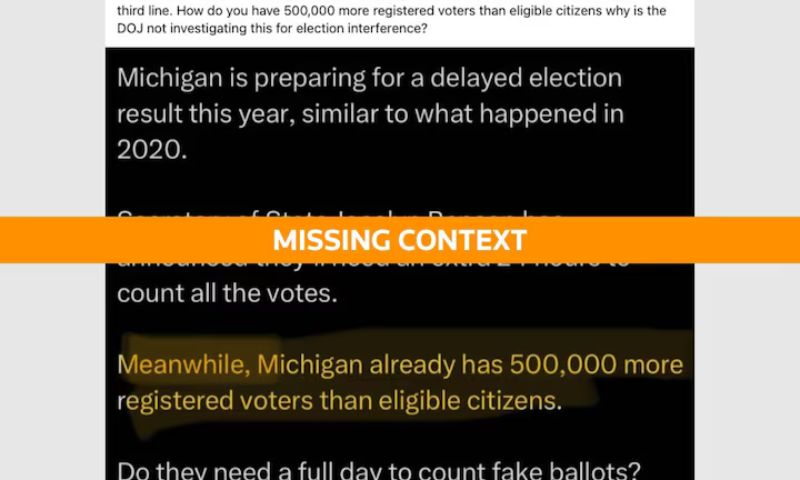WASHINGTON: Posts circulating online claim that Michigan has more registered voters than eligible voters. However, data from the Michigan State Department indicates that the state actually has fewer active registered voters than eligible ones. The records reveal that over a million registrations are classified as inactive.
One Facebook post promoting this narrative states, “Michigan is already trying to cheat,” citing a screenshot that claims, “Michigan has 500,000 more registered voters than eligible citizens.”
Reuters reported that Michigan, often considered a swing state in the upcoming U.S. presidential election on November 5, has a population of 10 million, with 7.6 million individuals aged 18 and over who are eligible to vote. According to the Michigan Department of State’s Voter Information Center, as of October 28, a week after the deadline for online and mail registrations, the state has over 8.4 million registered voters, but only 7.2 million of these are active. Eligible voters can still register in person until November 5.
A registered voter is deemed “inactive” if they haven’t cast a ballot in the last six years, which can also apply if the voter has died or moved. This means there are approximately 800,000 more total registered voters than eligible voters this year. However, officials confirm that only 7.2 million of the 8.4 million registered voters are active.
Keeping Voter Rolls Updated
The Michigan Secretary of State’s website states that local and state election officials employ various methods to identify inactive voters. For instance, when a voter changes their address within Michigan, their registration is updated accordingly. If a voter cancels their driver’s license in another state, the Michigan Department of State is notified.
Waiting Period for Cancellations
The reason there are more total registered voters, including both active and inactive, is due to the lengthy process of canceling a voter registration as mandated by federal and state law. There is a waiting period of two federal election cycles before an inactive voter can be removed from the rolls, which may take up to four years.
Quinn Yeargain, a professor of democracy law at Michigan State University, explained, “This safeguard ensures that eligible voters are not mistakenly removed. If that occurs, they would need to re-register and verify their identity again.”
Inactive Voters and Safeguards
A voter is marked as inactive after a cancellation notice is sent to their registered address in Michigan. Their registration will be canceled if there is no voting activity by the second federal election following the notice. Inactive voters are still allowed to vote until their registration is officially canceled.
There are several safeguards in place to prevent duplicate voting. Voting more than once in federal elections is a serious offense, carrying penalties of up to $10,000 in fines or five years in prison, or both. In Michigan, voting more than once in the same election or in different jurisdictions is a felony, punishable by up to $2,000 in fines or four years in prison.
When asked for comment, a spokesperson for the Michigan Department of State referred to the “Election Fact Center” section on their website.
Verdict
This claim lacks context. While Michigan does have more registered voters than eligible voters, it has fewer active registered voters than eligible ones, according to Reuters news agency.


























